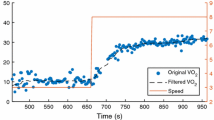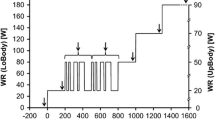Abstract
Introduction
Interpolation methods circumvent poor time resolution of breath-by-breath oxygen uptake (\(\dot{V}{\text{O}}_{2}\)) kinetics at exercise onset. We report an interpolation-free approach to the improvement of poor time resolution in the analysis of \(\dot{V}{\text{O}}_{2}\) kinetics.
Methods
Noiseless and noisy (10 % Gaussian noise) synthetic data were generated by Monte Carlo method from pre-selected parameters (Exact Parameters). Each data set comprised 10 (\(\dot{V}{\text{O}}_{2}\))-on transitions with noisy breath distribution within a physiological range. Transitions were superposed (no interpolation, None), then analysed by bi-exponential model. Fitted model parameters were compared with those from interpolation methods (average transition after Linear or Step 1-s interpolations), applied on the same data. Experimental data during cycling were also analysed. The 95 % confidence interval around a line of parameters’ equality was computed to analyse agreement between exact parameters and corresponding parameters of fitted functions.
Results
The line of parameters’ equality stayed within confidence intervals for noiseless synthetic parameters with None, unlike Step and Linear, indicating that None reproduced Exact Parameters. Noise addition reduced differences among pre-treatment procedures. Experimental data provided lower phase I time constants with None than with Step.
Conclusion
In conclusion, None revealed better precision and accuracy than Step and Linear, especially when phenomena characterized by time constants of <30 s are to be analysed. Therefore, we endorse the utilization of None to improve the quality of breath-by-breath \(\dot{V}{\text{O}}_{2}\) data during exercise transients, especially when a double exponential model is applied and phase I is accounted for.



Similar content being viewed by others
Abbreviations
- a 1 :
-
Amplitude of response of first exponential
- a 2 :
-
Amplitude of response of second exponential
- b :
-
Baseline resting \(\dot{V}{\text{O}}_{2}\) value
- d 1 :
-
Time delay of first exponential
- d 2 :
-
Time delay of second exponential
- T :
-
Time
- s:
-
Second
- \(\dot{V}{\text{O}}_{2}\) :
-
Oxygen uptake
- \(\theta\) :
-
Heaviside function
- \(\tau_{1}\) :
-
Time constant of first exponential
- \(\tau_{2}\) :
-
Time constant of second exponential
- \(\in\) :
-
Mathematical symbol meaning “is an element of”
References
Aliverti A, Kayser B, Cautero M, Dellacà RL, di Prampero PE, Capelli C (2009) Pulmonary V̇O2 kinetics at the onset of exercise is faster when actual changes in alveolar O2 stores are considered. Respir Physiol Neurobiol 169:78–82
Arieli R (1983) Cardiogenic oscillations in expired gas: origin and mechanism. Respir Physiol 52:191–204
Auchincloss JH Jr, Gilbert R, Baule GH (1966) Effect of ventilation on oxygen transfer during early exercise. J Appl Physiol 21:810–818
Barstow TJ, Molé PA (1987) Simulation of pulmonary O2 uptake during exercise transients in humans. J Appl Physiol 63:2253–2261
Barstow TJ, Molé PA (1991) Linear and nonlinear characteristics of oxygen uptake kinetics during heavy exercise. J Appl Physiol 71:2099–2106
Beaver WL, Lamarra N, Wasserman K (1981) Breath-by-breath measurement of true alveolar gas exchange. J Appl Physiol 51:1662–1675
Busso T, Robbins PA (1997) Evaluation of estimates of alveolar gas exchange by using a tidally ventilated nonhomogenous lung model. J Appl Physiol 82:1963–1971
Cala SJ, Kenyon CM, Ferrigno G, Carnevali P, Aliverti A, Pedotti A, Macklem PT, Rochester DF (1996) Chest wall and lung volume estimation by optical reflectance motion analysis. J Appl Physiol 81:2680–2689
Capelli C, Cautero M, di Prampero PE (2001) New perspectives in breath-by-breath determination of alveolar gas exchange in humans. Pflugers Arch 441:566–577
Cautero M, Beltrami AP, di Prampero PE, Capelli C (2002) Breath-by-breath alveolar oxygen transfer at the onset of step exercise in humans: methodological implications. Eur J Appl Physiol 88:203–213
Cautero M, di Prampero PE, Capelli C (2003) New acquisitions in the assessment of breath-by-breath alveolar gas transfer in humans. Eur J Appl Physiol 90:231–241
Coleman TF, Li Y (1996) An interior, trust region approach for nonlinear minimization subject to bounds. SIAM J Optim 6:418–445
Cummin AR, Iyawe VI, Mehta N, Saunders KB (1986) Ventilation and cardiac output during the onset of exercise, and during voluntary hyperventilation, in humans. J Physiol 370:567–583
Cumming G (1981) Gas mixing in disease. In: Scadding JD, Cumming G (eds) Scientific foundations of respiratory medicine. Heinemann, London, pp 688–697
di Prampero PE, Ferretti G (1999) The energetics of anaerobic muscle metabolism: a reappraisal of older and recent concepts. Respir Physiol 118:103–115
di Prampero PE, Lafortuna CL (1989) Breath-by-breath estimate of alveolar gas transfer variability in man at rest and during exercise. J Physiol 415:459–475
Grønlund J (1984) A new method for breath-to-breath determination of oxygen flux across the alveolar membrane. Eur J Appl Physiol Occup Physiol 52:167–172
Hughson RL, Cochrane JE, Butler GC (1993) Faster O2 uptake kinetics at onset of supine exercise with than without lower body negative pressure. J Appl Physiol 75:1962–1967
Lador F, Azabji Kenfack M, Moia C, Cautero M, Morel DR, Capelli C, Ferretti G (2006) Simultaneous determination of the kinetics of cardiac output, systemic O2 delivery, and lung O2 uptake at exercise onset in men. Am J Physiol Regul Integr Comp Physiol 290:R1071–R1079
Lamarra N, Whipp BJ, Ward SA, Wasserman K (1987) Effect of interbreath fluctuations on characterizing exercise gas exchange kinetics. J Appl Physiol 62:2003–2012
Lavenberg K (1944) A method for the solution of certain problems in least squares. Quart Appl Math 2:164–168
Lindholm D, Karlsson L, Gill H, Wigertz O, Linnarsson D (2006) Time components of circulatory transport from the lungs to a peripheral artery in humans. Eur J Appl Physiol 97:96–102
Marconi C, Heisler N, Meyer M, Weitz H, Pendergast DR, Cerretelli P, Piiper J (1988) Blood flow distribution and its temporal variability in stimulated dog gastrocnemius muscle. Respir Physiol 74:1–13
Marquardt D (1963) An algorithm for least-squares estimation of nonlinear parameters. SIAM J Appl Math 11:431–441
Meyer M, Calzia E, Mohr M, Schulz H, Neufeld G, Piiper J (1989) Cardiogenic mixing: mechanisms and experimental evidence in dogs. Br J Anaesth 63(Suppl 1):95S–101S
Murgatroyd SR, Ferguson C, Ward SA, Whipp BJ, Rossiter HB (2011) Pulmonary O2 uptake kinetics as a determinant of high-intensity exercise tolerance in humans. J Appl Physiol 110(6):1598–1606
Swanson GD, Sherrill DL (1983) A model evaluation of estimates of breath-to-breath alveolar gas exchange. J Appl Physiol 55:1936–1941
Wasserman K, Whipp BJ, Castagna J (1974) Cardiodynamic hyperpnea: hyperpnea secondary to cardiac output increase. J Appl Physiol 36:457–464
Weissman ML, Jones PW, Oren A, Lamarra N, Whipp BJ, Wasserman K (1982) Cardiac output increase and gas exchange at start of exercise. J Appl Physiol 52:236–244
Wessel HU, Stout RL, Bastanier CK, Paul MH (1979) Breath-by-breath variation of FRC: effect on VO2 and VCO2 measured at the mouth. J Appl Physiol 46:1122–1126
West JB, Dollery CT, Naimark A (1964) Distribution of blood flow in isolated lung; relation to vascular and alveolar pressures. J Appl Physiol 19:713–724
Whipp BJ, Wasserman K (1972) Oxygen uptake kinetics for various intensities of constant-load work. J Appl Physiol 33:351–356
Whipp BJ, Ward SA, Lamarra N, Davis JA, Wasserman K (1982) Parameters of ventilatory and gas exchange dynamics during exercise. J Appl Physiol 52:1506–1513
Acknowledgments
This study was supported by Swiss National Science Foundation Grants 32003B_127620 and 32003B_143427 to Guido Ferretti. The authors thank the volunteers for their implication in this study.
Author information
Authors and Affiliations
Corresponding author
Additional information
Communicated by Carsten Lundby.
Electronic supplementary material
Below is the link to the electronic supplementary material.
Rights and permissions
About this article
Cite this article
Bringard, A., Adami, A., Moia, C. et al. A new interpolation-free procedure for breath-by-breath analysis of oxygen uptake in exercise transients. Eur J Appl Physiol 114, 1983–1994 (2014). https://doi.org/10.1007/s00421-014-2920-z
Received:
Accepted:
Published:
Issue Date:
DOI: https://doi.org/10.1007/s00421-014-2920-z




